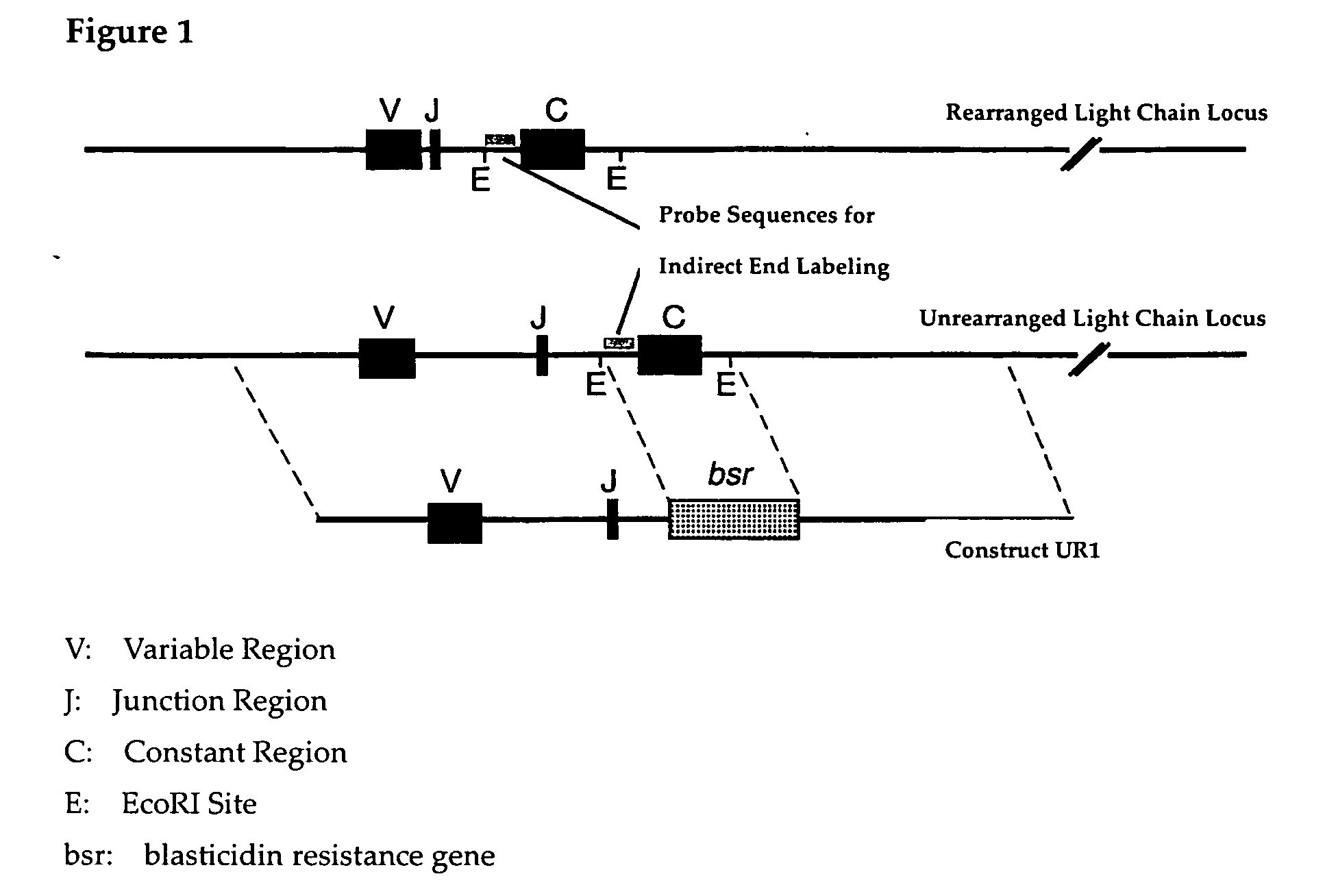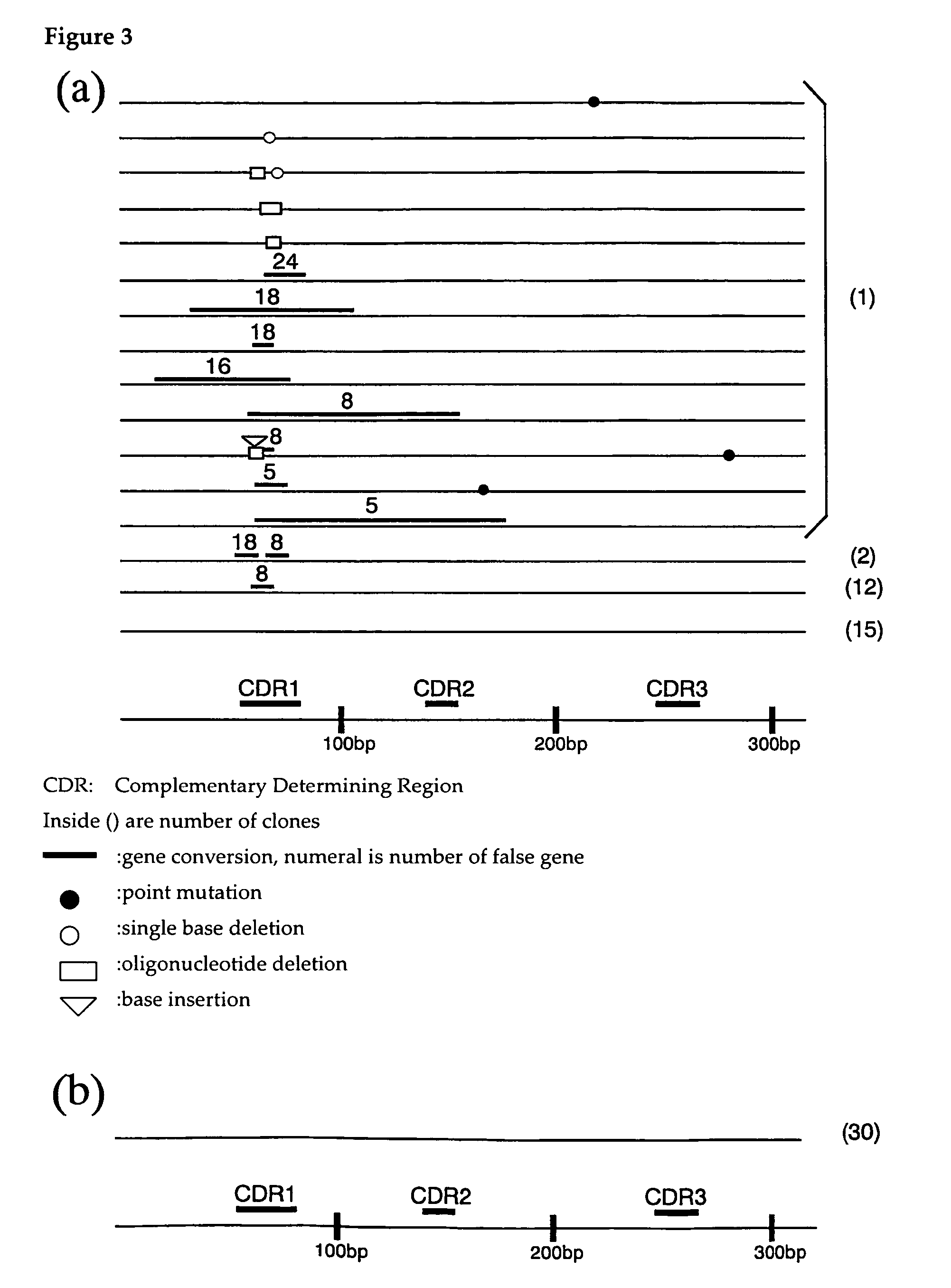Method of enhancing homologous recombination of somatic cells and method of constructing specific antibody
a technology of somatic cells and recombination, which is applied in the direction of fused cells, drug compositions, immunological disorders, etc., can solve the problems of difficult to stably obtain diverse antibodies at high titers, difficult to use alone for the creation of protein factors, and low recombination frequency, so as to promote somatic homologous recombination, promote dna homologous recombination at antibody locus, and promote r
- Summary
- Abstract
- Description
- Claims
- Application Information
AI Technical Summary
Benefits of technology
Problems solved by technology
Method used
Image
Examples
embodiment 1
Chromatin Structure in DT40 Cell Antibody Locus Region after Trichostatin A (TSA) Treatment
[0056] Whether an alteration of the chromatin structure of the antibody light chain gene has actually been produced by TSA was analyzed using indirect end labeling with micrococcal nuclease (MNase) sensitivity as an indicator. Among chicken antibody alleles, one is VJ rearranged and the other one is not rearranged, but it is known that actually functional in antibody production is VJ rearranged one. However, since both sequences are almost identical, it is difficult to analyze VJ rearranged allele of wild type DT40 cells by simple application of indirect end labeling method. In order to solve this problem, on the side for which VJ recombination has not occurred, a mutant of which sequences in the vicinity of the region to be used as a Southern hybridization probe is deleted is generated, and an analysis of MNase sensitivity using this mutant was performed.
Generation of Delet ion Mutant:
[005...
embodiment 2
of Promotion of Somatic Homologous Recombination at Antibody Locus of DT40 Cells by Trichostatin a (TSA)
Cell Culture:
[0062] DT40 cells were incubated at 39.5 degrees C. in a CO2 constant temperature oven in 5% CO2. IMDM medium (Invitrogen) was utilized as the medium, with 10% FBS, 1% chicken serum, 100 units / ml penicillin, 100 μg / ml streptomycin, and 55 μM 2-mercaptoethanol added. Additionally, for trichostatin A (Wako Pure Chemical Industries), this was dissolved to 5 mg / ml in methanol for stock, and this was used by diluting in an appropriate medium until the final concentration was 1.25 ng / ml.
[0063] DT40 cells that do not express IgM on their cell surfaces (herebelow, IgM (−) cells) were diluted to approximately 20 cells / ml and 100 μl each was pipetted into a 96 well plate. At this time, a medium with 1.25 ng / ml trichostatin A added, and a medium with this not added, were prepared. This was incubated until single colonies appeared, and 5 clones (For No TSA, 6 clones) were tran...
embodiment 3
Appearance Frequency of IgM(+) DT40 Cells Due to Trichostatin A
Confirmation of IgM Expression with a Fluorescence Activated Cell Sorter (FACS):
[0067] Culture fluid containing approximately 106 IgM(−) cells on which trichostatin A treatment was done by the method described in Embodiment 2 was put in 1.5 ml tubes, said cells were recovered by centrifuging (1000 g, 5 minutes), and suspended in 200 μl of staining buffer (PBS, 0.3% BSA). The cells were recovered by centrifuging again, then suspended in 200 μl of FITC-labeled anti chicken IgM antibody (BETHYL) diluted to 1 / 250 fold with a staining buffer, and reacted for 1 hour on ice. The cells were recovered by centrifuging, then the cells were washed by suspending them again in 200 μl of staining buffer, and centrifuging this. After repeating this washing step one more time, the cells were suspended in 100 μl of staining buffer containing 5 μg / ml of propidium iodide (Nakarai). The fraction of cells expressing IgM was calculated by me...
PUM
| Property | Measurement | Unit |
|---|---|---|
| Time | aaaaa | aaaaa |
| Time | aaaaa | aaaaa |
| Concentration | aaaaa | aaaaa |
Abstract
Description
Claims
Application Information
 Login to View More
Login to View More - R&D
- Intellectual Property
- Life Sciences
- Materials
- Tech Scout
- Unparalleled Data Quality
- Higher Quality Content
- 60% Fewer Hallucinations
Browse by: Latest US Patents, China's latest patents, Technical Efficacy Thesaurus, Application Domain, Technology Topic, Popular Technical Reports.
© 2025 PatSnap. All rights reserved.Legal|Privacy policy|Modern Slavery Act Transparency Statement|Sitemap|About US| Contact US: help@patsnap.com



